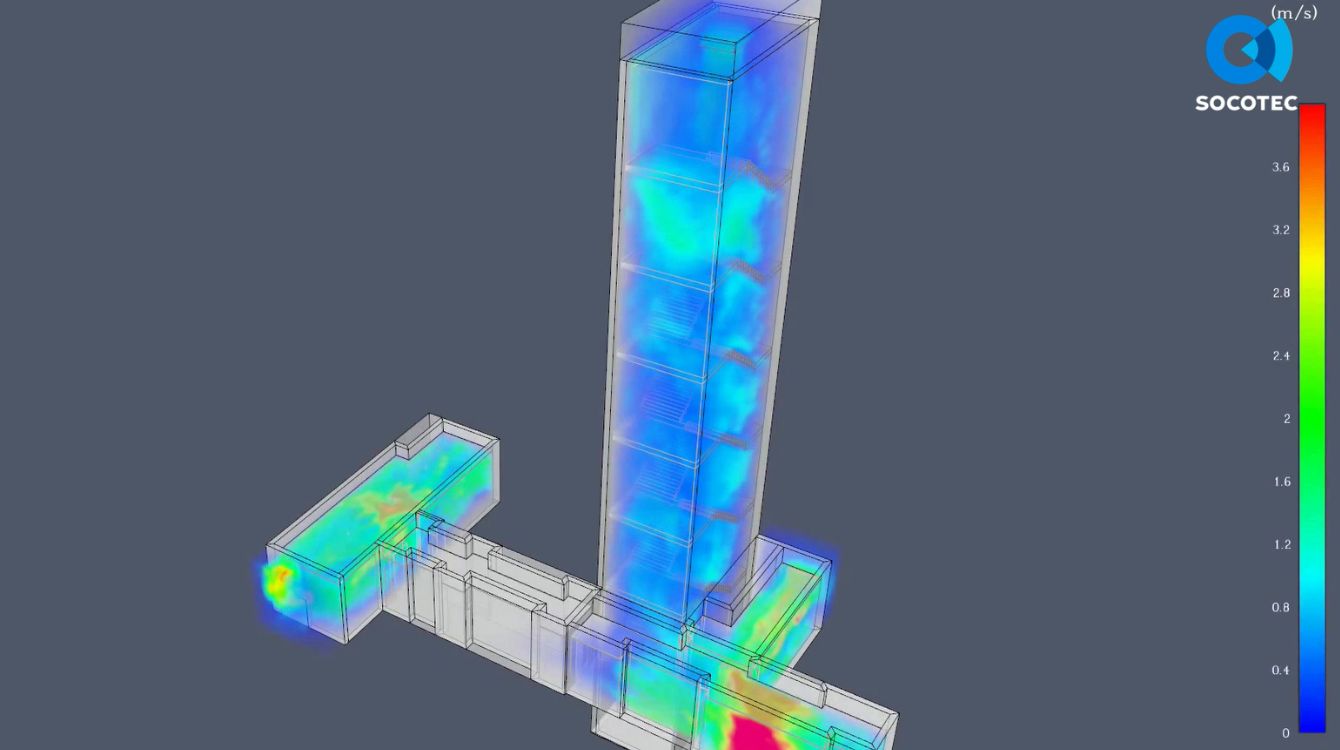Need some advice?
Leave your details and we will get in touch.
I want to be contacted by an expert1 /
Simon Drake, Senior Fire Modelling Engineer at SOCOTEC UK and Ireland, has 40 years of experience within the Computational Fluid Dynamics (CFD) modelling field. Within that time, he has seen a wealth of changes, watching CFD modelling go from a niche technology to an essential engineering tool.

We spoke to Simon, to find out just how CFD modelling has changed, and why its continued use is incredibly important.
“CFD modelling has transformed remarkably over my 40-year career in the field. I've been fortunate to work with CFD continuously throughout this time, across approximately a dozen companies.
“Computer hardware has changed incredibly - you can now build bigger models with larger amounts of RAM and do your CFD calculations much quicker with faster processors.
“When I began my career, CFD was conducted on large mainframes, as desktop computers weren't yet powerful enough for this complex work. It wasn't part of mainstream engineering, the advent of desktop computers capable of serious computational work marked a profound change, facilitating CFD's integration into everyday engineering practice.
“Another significant development came with the ability to parallelise calculations: we actually had very big increases in speed, which was quite a profound improvement. More recently, advancements have included the incorporation of CFD into fluid structure modelling, combining it with solid mechanics and structural engineering. That requires a good knowledge of whatever mix of physics you're modelling, not just fluid dynamics.
“Looking toward the future, I believe artificial intelligence represents the next frontier: it may well make CFD much easier to use. While I haven't personally been involved in AI development, normally referred to as machine learning with CFD, I recognise its potential to totally transform the field.”
“I initially entered this field somewhat accidentally: I got into CFD modelling by accident, without fully appreciating quite what it was. I was seeking work with an engineering consultancy specialising in energy and heat transfer, and while I didn't fully understand what CFD entailed, it aligned with my interests.
“Learning the technology proved challenging initially, but once I grasped the fundamentals, I discovered what I consider, possibly, the ultimate transferable skill.
“General purpose CFD can be used in all sorts of engineering fields that involve fluid mechanics - and most of them do. It's used extensively in the oil and gas industry, building services, fire modelling, and even the metallurgy industry. It can even simulate fluid flows around the human body, CFD is truly an incredible transferable skill.
“Throughout my career, I've applied this versatility across numerous high-profile projects, including: The Jubilee Line extension project, Istanbul's Marmaray project, featuring a tunnel section under the Bosphorus, Doha Metro, Bangkok Metro, Various US metro lines and London Underground's Crossrail.
“My work has involved smoke control, ventilation design, looking at underground networks as well as individual stations, and examining details such as platform and train fires in stations.
“I've also modelled fires in football stadiums, stations and tunnels, shopping malls, all sorts of places – truly demonstrating the remarkable range of applications CFD offers.”
“The perception and understanding of CFD among clients has evolved significantly during my career. In the early days, these would be first-timers to CFD, in the early 80s, it was a young technology.
“Most early clients were unfamiliar with what CFD entailed, they wouldn't necessarily know what they were in for, they just knew they were coming to explore the possibility, or they'd been recommended to consult with experts who used this virtual simulation technique that could replace physical testing.”
“Its potential was to replace the physical testing they might have done in the past, or in some cases, just hand calculations using empirical formulas.”
“Nowadays, things have changed hugely, a lot of clients have heard enough about CFD to have a basic level of understanding. This is unlike the early days of my career when you actually had to educate every single client you met.
“Generally speaking, you just have to tell them that CFD analysis is not going to be simple. It's not the expensive service it used to be, but it's still not something that's particularly cheap either.”
“When presenting modelling results to clients, I often emphasise the importance of clear communication. You need to make sure you don't fall into the trap of using expert lingo. It's very important to stick to plain English.
“The moment you start using buzzwords specific to either the technology or the industry, you start losing people. You can lose people completely once you get a couple of occasions when they're not understanding what you're referring to."
“Fortunately for us, CFD's visual nature facilitates communication, having the graphics you can use for presenting your work is really helpful, and helps to make complex concepts accessible.
“If you see the geometry of the building and vector pictures projected through it, you can get an intuitive understanding of how air is moving in that building.
“If you show contour plots on 2D planes, you can see contours of temperature from red through to blue, and get an intuitive understanding of temperature distribution.”
“Having recently joined SOCOTEC as a Senior Fire Modelling Engineer, I'm enthusiastic about the opportunities ahead - particularly with an increased variety in applications of CFD.
“At this stage in my career, knowledge transfer has become increasingly important to me. I would really like to impart as much of my knowledge and experience to younger engineers as I can.
“And, though CFD has matured considerably over four decades, I still believe there's significant potential for growth. Although it's a mature technology and part of mainstream engineering, there's still a lot of development to go, which will be exciting to follow in my role at SOCOTEC.”

Watch the full interview here
The Changing Face of CFD Modelling

